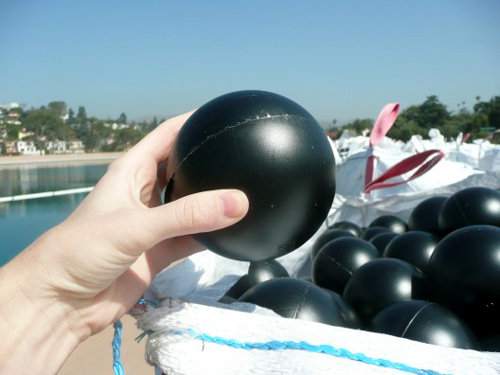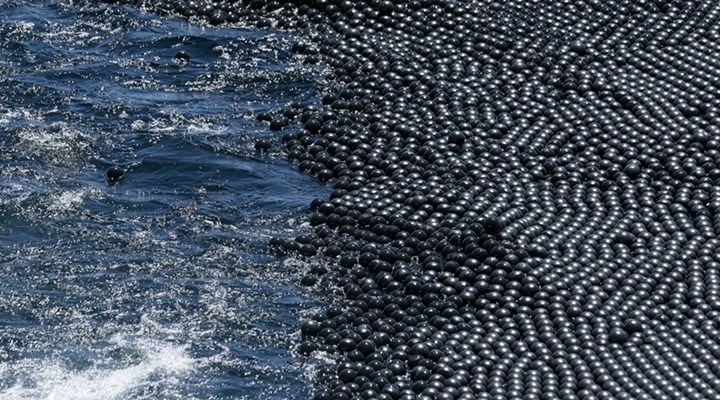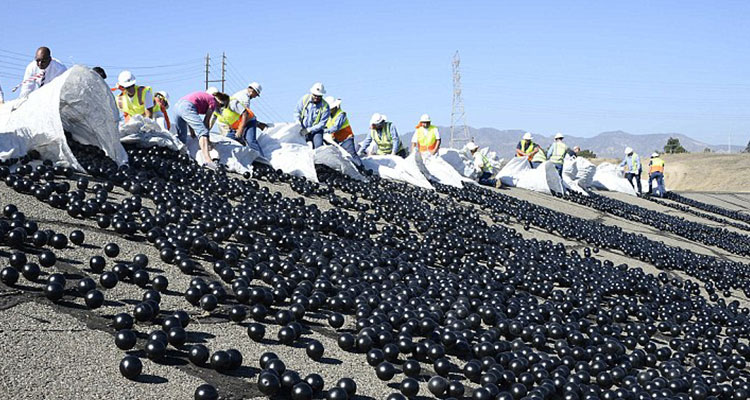The severe drought in California and the innovative plan to fill the reservoir with “shade balls” presents an ideal opportunity for kids to learn the causes and effects of droughts in the environment, what it means for them, and how these shade balls may help the situation. Read on as Daniel Franck, director of science for K12, explains the science behind the drought and the reason that 96 million plastic balls were dispatched to combat it:
I grew up in California. As a boy, I used to play baseball on an asphalt school yard in heat that often reached 105 degrees Fahrenheit, or more. It was a dry heat too, as they say, but we would play in it relentlessly until a majority of us got spontaneous nosebleeds; only then would we stop playing.
On other days, my parents would put the kids in a 1956 Ford station wagon and drive us to a scenic spot—and I would look at the immense canals that carry water all around California and wonder why these aqueducts were left uncovered. The evaporation, the water loss, had to be enormous. Even as a boy, I worried that more water was lost than finally got to the fields around Fresno or Merced in the great Central Valley.
Then as now, the summers in California are hot and utterly without rain. And now, the winters aren’t helping much. The Golden State is in the middle of a very serious drought that has lasted for four years. Some say this is the worst drought in the area in 1,200 years. Whatever the cause, it is a problem that must be addressed.
Like a lot of us, I worry about those 36 million people dealing with real water scarcity. My family still lives there. What to do? Californians already live with a spate of laws about when and how to water their lawns—or even if they can have lawns. Anyone who has seen Chinatown knows that water is the lifeblood of the economy. California preserves its water in gigantic reservoirs throughout the state and transports it in enormous canals. One huge issue is how to prevent the water we do have from being lost to the process of evaporation. A second is keeping this water safe enough to drink.
Lately, a dramatic solution has been employed, especially in the Los Angeles area. If necessity is the mother of invention, then the idea of covering the entire surface of a huge reservoir with shade balls is certainly an idea born of real necessity.
The reservoir that holds much of the water used in the city of Los Angeles is located in Sylmar. The reservoir is 175 acres of water surface baked by the demanding western sun. The reservoir holds 3.3 billion gallons of water. That may seem like a lot but it is only enough to provide the people of Los Angeles with drinking water for three weeks.
Astoundingly, the Los Angeles Department of Water and Power (LADWP) has now placed 96 million—let me repeat that, 96 MILLION—small black plastic balls, called shade balls, in the reservoir. They float on the top of the water and scientists and engineers tell us that these balls reduce evaporation by up to 90 percent. At Sylmar alone, over 300 million gallons of water can now be retained as liquid water per year.

The balls are four inches in diameter and are made of polyethylene and coated with a chemical to block UV light. Artisan Screen Process, Orange Products, and XavierC, who make the balls, say they don’t break down chemically and thus will not affect water quality. The sight of a vast reservoir covered with black balls is a relatively new one in human history, and amazing to look at, too!

Shade balls have been around since about 2008, when the idea first proposed by LADWP Biologist Brian White was put into effect. Initially, the balls were put into Los Angeles’ Ivanhoe Reservoir to reduce UV light hitting the water. It turns out the UV light reacts with chlorine in the water to make bromate, which can be a carcinogen. The entire reservoir was drained, decontaminated, and then filled up again. The balls had been added as a way to keep the water bromide-free. Recently, however the idea has been employed to reduce evaporation as well, and the sight of LA Mayor Eric Garcetti launching another 20,000 balls at Sylmar received national attention.
As you might expect, the concept of dropping 96 million polyethylene balls into people’s drinking water has met with some resistance. There have been reports that the balls will last up to ten years, but even if they are useful for 25 years, then what? We have to figure out what to do with 96 million black balls from the LA reservoir alone. Critics also note that drinking water is not really the major issue at all—agriculture is. Scenic rivers hold up to 30 percent of the water. Up to 40 percent of California’s water is used to grow plants. It seems also that a lot of water is used on California’s golf courses. Almonds need a lot of water. Alfalfa is another huge water sink. It takes 700 gallons of water to make enough alfalfa to make one gallon of milk. To get four ounces of beef? That takes 425 gallons of water.
I live in New York State now, and the summers are green and the water is plentiful. My well never runs dry. In fact, my basement leaks in July from all the rain. But I remember California and how brown the hills are all summer. This drought Californians are going through now is quite serious. It’s worse than when I was a boy, and that is saying something. Drought changes history. Just ask the grandsons and granddaughters of everyone who left Texas and Oklahoma in the 1930s, at the height of the Dust Bowl. The whole course of human history is written in the expansion and contraction of the Sahara Desert. Will shade balls help? It’s too early to tell, but you have to admit it’s a unique solution, and unique solutions are called for in difficult times.
Featured Image – Gene Blevins/ REX Shutterstock

















































































































